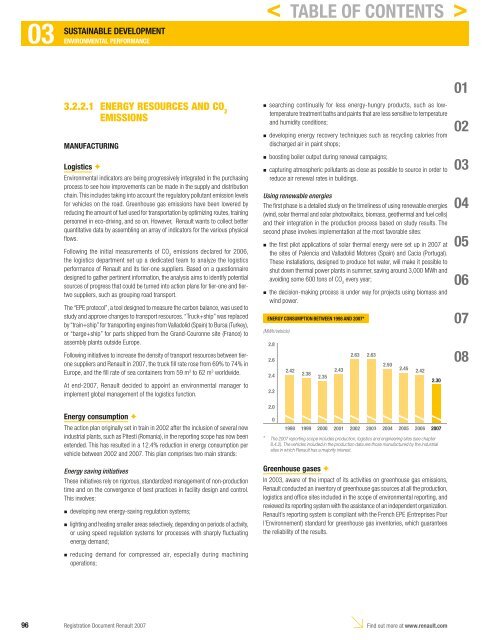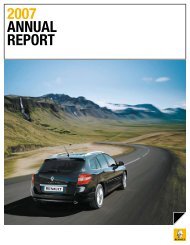2007 Interactive Registration Document - Renault
2007 Interactive Registration Document - Renault
2007 Interactive Registration Document - Renault
Create successful ePaper yourself
Turn your PDF publications into a flip-book with our unique Google optimized e-Paper software.
03 ENVIRONMENTAL<br />
SUSTAINABLE DEVELOPMENT<br />
PERFORMANCE<br />
3.2.2.1 ENERGY RESOURCES AND CO 2<br />
EMISSIONS<br />
MANUFACTURING<br />
Logistics ✦<br />
Environmental indicators are being progressively integrated in the purchasing<br />
process to see how improvements can be made in the supply and distribution<br />
chain. This includes taking into account the regulatory pollutant emission levels<br />
for vehicles on the road. Greenhouse gas emissions have been lowered by<br />
reducing the amount of fuel used for transportation by optimizing routes, training<br />
personnel in eco-driving, and so on. However, <strong>Renault</strong> wants to collect better<br />
quantitative data by assembling an array of indicators for the various physical<br />
fl ows.<br />
Following the initial measurements of CO 2 emissions declared for 2006,<br />
the logistics department set up a dedicated team to analyze the logistics<br />
performance of <strong>Renault</strong> and its tier-one suppliers. Based on a questionnaire<br />
designed to gather pertinent information, the analysis aims to identify potential<br />
sources of progress that could be turned into action plans for tier-one and tiertwo<br />
suppliers, such as grouping road transport.<br />
The “EPE protocol”, a tool designed to measure the carbon balance, was used to<br />
study and approve changes to transport resources. “Truck+ship” was replaced<br />
by “train+ship” for transporting engines from Valladolid (Spain) to Bursa (Turkey),<br />
or “barge+ship” for parts shipped from the Grand-Couronne site (France) to<br />
assembly plants outside Europe.<br />
Following initiatives to increase the density of transport resources between tierone<br />
suppliers and <strong>Renault</strong> in <strong>2007</strong>, the truck fi ll rate rose from 69% to 74% in<br />
Europe, and the fi ll rate of sea containers from 59 m 3 to 62 m 3 worldwide.<br />
At end-<strong>2007</strong>, <strong>Renault</strong> decided to appoint an environmental manager to<br />
implement global management of the logistics function.<br />
Energy consumption ✦<br />
The action plan originally set in train in 2002 after the inclusion of several new<br />
industrial plants, such as Pitesti (Romania), in the reporting scope has now been<br />
extended. This has resulted in a 12.4% reduction in energy consumption per<br />
vehicle between 2002 and <strong>2007</strong>. This plan comprises two main strands:<br />
Energy saving initiatives<br />
These initiatives rely on rigorous, standardized management of non-production<br />
time and on the convergence of best practices in facility design and control.<br />
This involves:<br />
n<br />
n<br />
n<br />
developing new energy-saving regulation systems;<br />
lighting and heating smaller areas selectively, depending on periods of activity,<br />
or using speed regulation systems for processes with sharply fl uctuating<br />
energy demand;<br />
reducing demand for compressed air, especially during machining<br />
operations;<br />
searching continually for less energy-hungry products, such as lowtemperature<br />
treatment baths and paints that are less sensitive to temperature<br />
and humidity conditions;<br />
developing energy recovery techniques such as recycling calories from<br />
discharged air in paint shops;<br />
boosting boiler output during renewal campaigns;<br />
capturing atmospheric pollutants as close as possible to source in order to<br />
reduce air renewal rates in buildings.<br />
Using renewable energies<br />
The fi rst phase is a detailed study on the timeliness of using renewable energies<br />
(wind, solar thermal and solar photovoltaics, biomass, geothermal and fuel cells)<br />
and their integration in the production process based on study results. The<br />
second phase involves implementation at the most favorable sites:<br />
the fi rst pilot applications of solar thermal energy were set up in <strong>2007</strong> at<br />
the sites of Palencia and Valladolid Motores (Spain) and Cacia (Portugal).<br />
These installations, designed to produce hot water, will make it possible to<br />
shut down thermal power plants in summer, saving around 3,000 MWh and<br />
avoiding some 600 tons of CO 2 every year;<br />
the decision-making process is under way for projects using biomass and<br />
wind power.<br />
ENERGY CONSUMPTION BETWEEN 1998 AND <strong>2007</strong>*<br />
* The <strong>2007</strong> reporting scope includes production, logistics and engineering sites (see c hapter<br />
8.4.2). The vehicles included in the production data are those manufactured by the industrial<br />
sites in which <strong>Renault</strong> has a majority interest.<br />
Greenhouse gases ✦<br />
In 2003, aware of the impact of its activities on greenhouse gas emissions,<br />
<strong>Renault</strong> conducted an inventory of greenhouse gas sources at all the production,<br />
logistics and offi ce sites included in the scope of environmental reporting, and<br />
reviewed its reporting system with the assistance of an independent organization.<br />
<strong>Renault</strong>’s reporting system is compliant with the French EPE (Entreprises Pour<br />
l’Environnement) standard for greenhouse gas inventories, which guarantees<br />
the reliability of the results.<br />
96 <strong>Registration</strong> <strong>Document</strong> <strong>Renault</strong> <strong>2007</strong><br />
Find out more at www.renault.com<br />
n<br />
n<br />
n<br />
n<br />
n<br />
n<br />
< TABLE OF CONTENTS ><br />
01<br />
02<br />
03<br />
04<br />
05<br />
06<br />
07<br />
08




